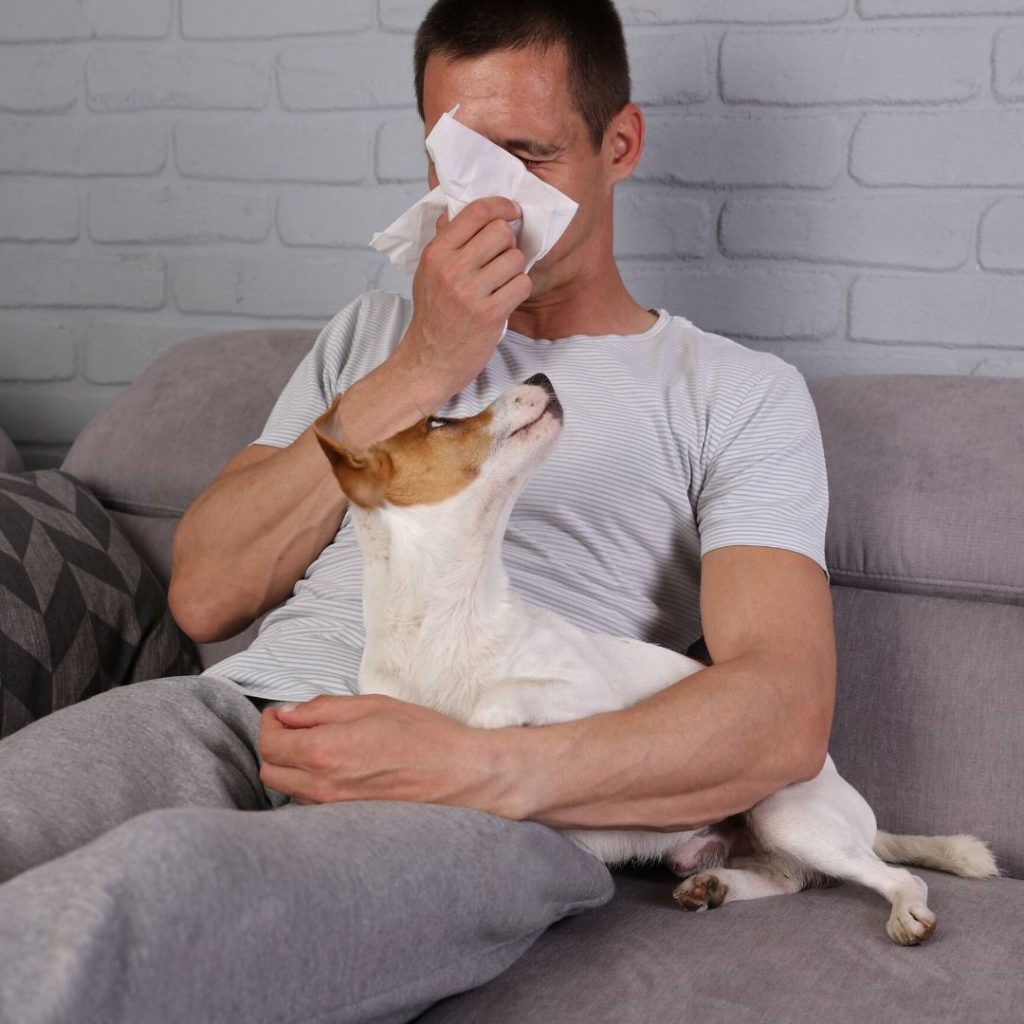Spring appears to be in full flow now. Despite COVID-19, most of us are thrilled that the sun is out more and the ground is warming up. For those of you who suffer from hay fever or another allergy, it’s time to break out the antihistamines. But what about our dogs?
Dogs can suffer from allergies, which we split into two major categories. ‘Atopic dermatitis’ is an allergy to the environment- pollens, dust mites and weeds that are borne in the air. ‘Adverse food reaction’ can show exactly the same symptoms, but the allergy is in the diet.
Which dogs are prone to allergies?

All breeds, ages and genders of dogs can be allergic. But there are some factors that make allergies more or less likely.
Most dogs are diagnosed with allergies- or first show symptoms of allergies- between 6 months and 3 years of age. If your dog is older than three years and has never shown signs before, it is less likely that they have allergies, although not impossible. Atopic dermatitis in dogs under 6 months is rare, but sporadic cases are not unheard of.
Some breeds seem to be more prone to allergies than others, but this varies from year to year and by location. For instance, in the 1970s English Setters were the most predisposed to allergy problems, but in the 1960s at the same university they were no more likely to get it than any other breed- this is probably due to different genetic lines being used that brought in problems, changing the breed status very quickly. On the whole, vets agree that Boston terriers, boxers, Chinese shar-pei, English bulldogs, French bulldogs, Labrador retrievers, West Highland white terriers, German Shepherds and Yorkshire terriers are probably more likely than other breeds to have allergies.
As for gender, the jury is still out whether one gender is more predisposed than the other to suffer from an allergy. Some studies have found females get it more often, others have found males to be more at risk. It’s probably safe to say that both genders seem to be equally likely to get it at the moment.
What are the symptoms of allergies in dogs?
Allergies in dogs rarely present with runny eyes and sneezing, although sometimes a mild redness around the eyes is noted. It’s far more likely that your pet will experience recurrent ear infections or repetitive licking or chewing of the feet. Itchiness, especially of the face or underbelly, is a key sign. Some severely affected dogs will lose fur or have skin thickening due to the constant irritation.
Other signs include:
- Itching, especially the face, neck, and abdomen
- Ear infections in one or both ears
- Licking or chewing at the feet
- Patches of hair loss, especially around the eyes, muzzle and behind elbows.
- Recurrent sores and skin infections
- Pink staining on white fur (saliva staining where excessive licking has occurred)
It’s worth mentioning that, like hay fever in humans, some dogs get these symptoms for only a few months of the year. However, many dogs are allergic to allergens that are present year-round, such as ingredients in their food or mites in the house.
What could my dog be allergic to?
The list of potential allergens is long. And vets and scientists can’t even agree on which allergens are most common. However, the commonly tested-for allergens in the UK are grasses (such as orchard grass and timothy grass), pollen (like oil-seed rape pollen or rye pollen), mites (such as the house dust mite and the hay mite), trees (such as sycamore, elm and willow), weeds (such as nettle, plantain and dandelion) and fungi (such as Aspergillus and Malassezia). They also test for allergies to flea bites, which are common in cats and dogs. It’s quite common for dogs to react to more than one of these allergens!
Dogs can be allergic to ingredients in their food, too. This is much less common, making up only about 1 in 10 allergies. The most common food allergen appears to be beef, although dogs can be allergic to any protein in their diet. And, contrary to popular opinion, allergy to grains is rare- making up only 1 in 10 food allergies. Food allergies cannot be diagnosed by blood test like environmental allergens, as the results are not reliable. Instead, strict dietary control is required to see whether a change to the diet makes a difference.
How will my vet be able to help my dog?
Allergies are frustrating for both dog and owner. And they can be severe, resulting in skin infections that can be difficult to get rid of. They also tend to get worse over time. What you probably don’t realise is that these cases are frustrating for your vet, too. There are lots of different tests and medications, and not all work with every case- so a lot of patience and trial-and-error is needed to make a dog more comfortable.
Your vet can prescribe anti-itch medications to give your dog some temporary relief. They can also undertake testing to discover what your dog is allergic to, then create an allergen vaccination- the idea being that if you expose the dog to tiny amounts of the allergen, over time they’ll learn to tolerate it.
For complex cases that are not responding to the usual therapies, your vet might recommend that you see a dermatologist. Allergic dogs make up over a quarter of a veterinary dermatologist’s workload- so they really have seen it all- and they can make a huge difference to dogs struggling with their allergies.
Why are shampoos helpful?
Shampoos are really important when tackling allergic dermatitis in the dog. Firstly, the act of shampooing, with a shampoo like Dog Hair Day, physically removes dust, dirt, pollen and other allergens present in the fur, thereby reducing the allergen load significantly, if only temporarily. Loose fur is often also removed, reducing the itch. Shampooing with an emollient shampoo has been found to be one of the most reliable, if short-term, treatments for allergies, although it is usually only sufficient for dogs suffering with a mild atopic dermatitis. It is thought that the frequency of bathing is important- too often, and the skin may become dry, and therefore itchier. Not often enough and the beneficial effects are not felt. It’s worth starting with a frequency recommended by your vet, then adjusting it until you’ve found the perfect frequency for your pet.
Allergies are really frustrating to deal with, so it’s important that you work together with your vet to find the therapy that works best for your dog.

